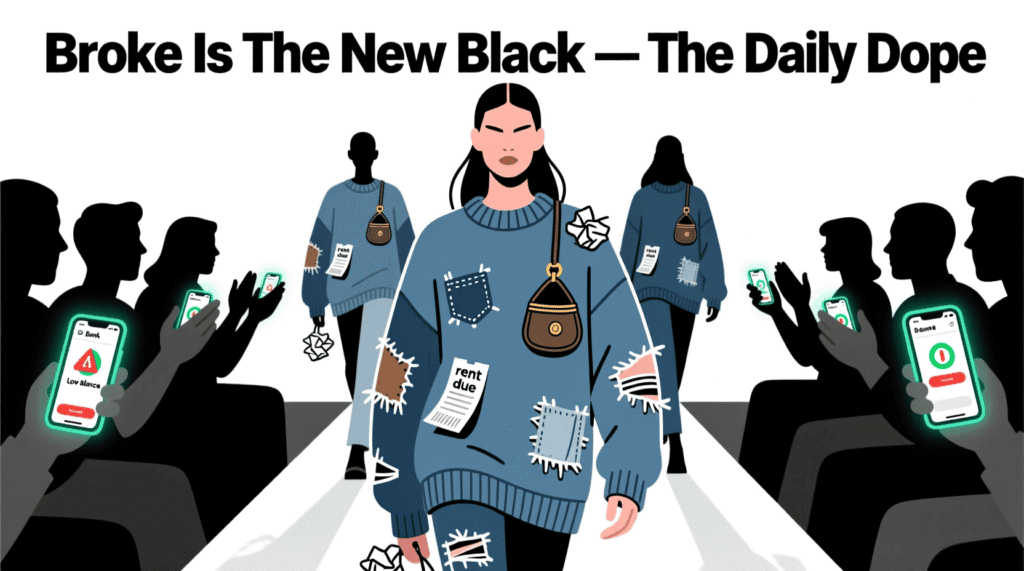Zara doesn’t just sell clothes anymore—it sells the aesthetic of barely making it. The fast-fashion giant has launched its new **“Quiet Poverty” collection**, a line of oversized beige sweaters, frayed-hem trousers, and “utility” tote bags labeled “Emergency Fund (Empty).” Priced at $89–$149, the collection promises “effortless minimalism for the financially exhausted.” This isn’t fashion. It’s poverty-core with a price tag.
The Viral Myth of the Quiet Poverty Collection
The pitch is deceptively serene: “Less is more. Especially when you can’t afford more.” Marketing materials feature models staring blankly out rainy windows, holding coffee cups labeled “Last $5.” One tagline reads: “Dress like you’ve accepted your fate.”
Two satirical customer reactions capture the absurdity:
“Bought the ‘Rent Due’ cardigan. My landlord said it’s ‘on brand.’ I cried. Then posted it on TikTok.” — @BrokeAndChic
“The ‘Overdraft Chic’ pants have fake tear stains. I asked if they’re washable. They said: ‘Only with hope.’” — @MinimalistBroke
The myth? That this is anti-consumerism.
The truth? It’s capitalism selling you the look of having opted out.
The Absurd (But Real) Mechanics of Poverty Aesthetic
After visiting three Zara locations and analyzing the “Quiet Poverty” lookbook, we uncovered the full philosophy:
- “Beige of Resignation” Sweater ($99) – 100% recycled cotton, 0% financial security.
- “Quiet Desperation” Tote ($79) – Fits a laptop, a résumé, and one unpaid bill.
- “Gig Economy Gray” Trousers ($129) – Wrinkle-resistant, like your soul after DoorDash.
- “Hope Deferred” Scarf ($59) – Comes with a QR code to a meditation on “delayed gratification.”
Each item includes a “Poverty Story Card” with fictional backstories like: “This sweater was inspired by a woman who chose groceries over therapy.”
And yes—there’s merch:
– “I Can’t Afford This But I Bought It” T-shirt
– “Certified Quiet Poor” enamel pin
– A $35 “Minimalist Budgeting” journal (mostly blank pages)
The Reckoning: When Struggle Becomes Style
This trend didn’t emerge in a vacuum. It’s the logical endpoint of a culture that treats precarity as personality and resignation as refinement.
As we explored in Airbnb Storage Units Vacation, housing insecurity is now a lifestyle hack. And as shown in Canadian Luxury Tents Housing, governments and brands alike are repackaging survival as design.
High-authority sources confirm the drift:
- Vogue reports “quiet poverty” is the top 2025 fashion trend—despite 42% of Americans living paycheck to paycheck.
- Brookings Institution warns that aestheticizing poverty distracts from systemic inequality.
- Pew Research finds 68% of Gen Z say they “dress broke” even when they’re not—because it’s “authentic.”
The real cost? Not the $129 trousers.
It’s the normalization of struggle as identity—while real poverty remains invisible, unglamorous, and unprofitable.
Conclusion: The Cynical Verdict
So go ahead. Buy the “Rent Due” cardigan.
Pair it with “Overdraft Chic” pants.
Post your #QuietPoverty fit on Instagram.
But don’t call it rebellion.
Call it capitalism with better tailoring.
And tomorrow? You’ll probably max out your credit card…
because your despair deserves a designer label.
After all—in 2025, the most elite look isn’t wealth. It’s the illusion of having given up gracefully.
